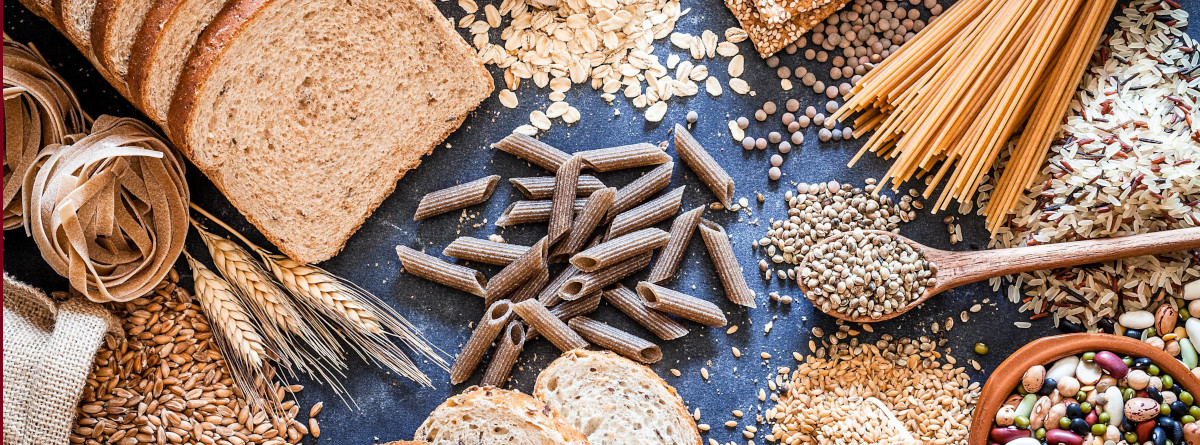
Grains provide many nutrients that are vital for the health and maintenance of our bodies, including:
- Dietary fiber from whole grains or other foods may help reduce blood cholesterol levels and may lower the risk of heart disease, obesity, and type 2 diabetes. Fiber is important for proper bowel function. It helps reduce constipation and diverticulosis. Fiber-containing foods such as whole grains help provide a feeling of fullness with fewer calories.
- The B vitamins thiamin, riboflavin, and niacin play a key role in metabolism– they help the body release energy from protein, fat, and carbohydrates. B vitamins are also essential for a healthy nervous system. Many refined grains are enriched with these B vitamins.
- Folate (folic acid), another B vitamin, helps the body form red blood cells.
- Iron is used to carry oxygen in the blood.
- Magnesium is a mineral used in building bones and releasing energy from muscles.
- Selenium protects cells from oxidation. It is also important for a healthy immune system.
What is a whole grain?
A grain is a kernel that has three parts—the bran, germ and endosperm. Foods or flour that use all parts of the grain kernel are whole grains.
Foods that don’t use the whole grain are called refined grains. The refining process, or milling the grain, removes the bran and the germ. This gives the grain a finer texture and improves the shelf life. But, it also removes the dietary fiber, iron, and many of the B vitamins. Enriched flour is refined flour that has B vitamins and iron added back after milling. The process of enriching flour does not add back any fiber. Most packaged foods are made from refined grains. Whole grains have more vitamins, minerals and fiber because these nutrients are contained in the bran and the germ.
How many servings of grains should you eat?
The amount of grains you need to eat depends on your age, sex, and level of physical activity. Recommended daily amounts are given in ounce equivalents, and range from 5- to 8-ounce equivalents for adults, and from 3- to 8-ounce equivalents for children and teens. Most Americans consume enough grains, but few are whole grains. At least half of all the grains you eat should be whole grains.
Any food made from wheat, rice, oats, cornmeal, barley or another cereal grain is a grain product. Bread, pasta, oatmeal, breakfast cereals, tortillas and grits are examples of grain products.
Tips for eating whole grains
- To eat more whole grains, substitute a whole-grain product for a refined product, such as eating whole-wheat bread instead of white bread or brown rice instead of white rice. Make sure you substitute the whole-grain product for the refined one, rather than adding the whole-grain product.
- Use whole grains in mixed dishes, such as barley in vegetable soup or stews and bulgur wheat in a casserole or stir-fry.
- Create a whole grain pilaf with a mixture of barley, wild rice, brown rice, broth and spices. For a special touch, stir in toasted nuts or chopped dried fruit.
- Experiment by substituting whole wheat or oat flour for up to half of the flour in pancake, waffle, muffin or other flour-based recipes. They may need a bit more leavening.
- Use whole-grain bread or cracker crumbs in meatloaf.
- Try rolled oats or a crushed, unsweetened whole grain cereal as breading for baked chicken, fish, veal cutlets or eggplant parmesan.
- Freeze leftover cooked brown rice, bulgur or barley. Heat and serve it later as a quick side dish.
- Popcorn, a whole grain, can be a healthy snack if made with little or no added salt and butter.
- Read labels carefully to look for whole-grain ingredients. Foods labeled with the words "multi-grain," "stone-ground," "100% wheat," "cracked wheat," "seven-grain" or "bran" are usually not whole-grain products. Color is not an indication of a whole grain. Bread can be brown because of molasses or other added ingredients.
List of whole grains
Look for the following words to find whole-grain ingredients:
- Brown rice
- Buckwheat
- Bulgur
- Millet
- Oatmeal
- Popcorn
- Quinoa
- Rolled oats
- Whole-grain barley
- Whole-grain corn
- Whole-grain sorghum
- Whole-grain triticale
- Whole oats
- Whole rye
- Whole wheat
- Wild rice